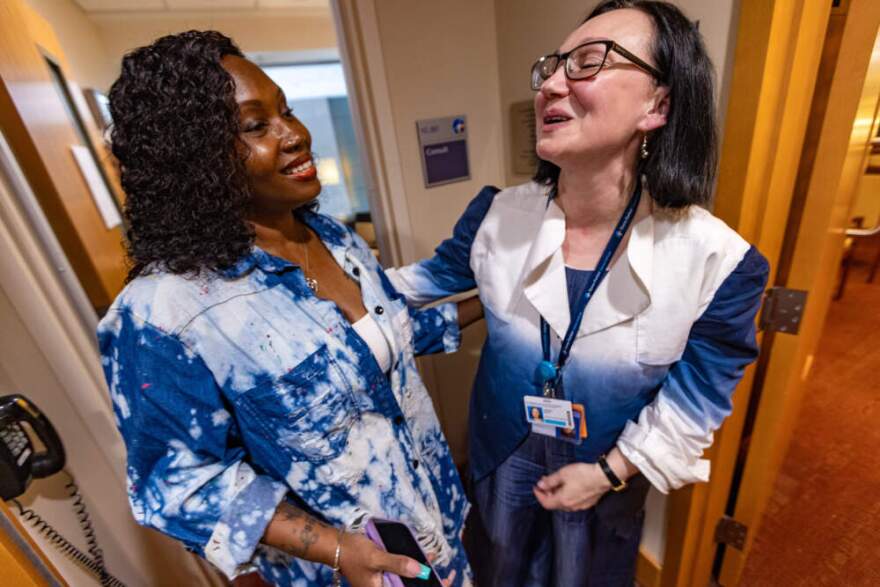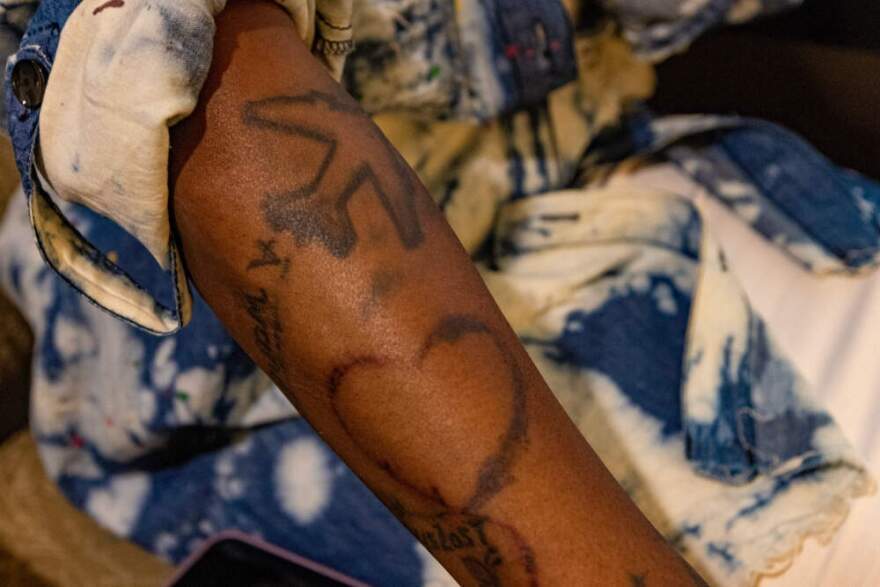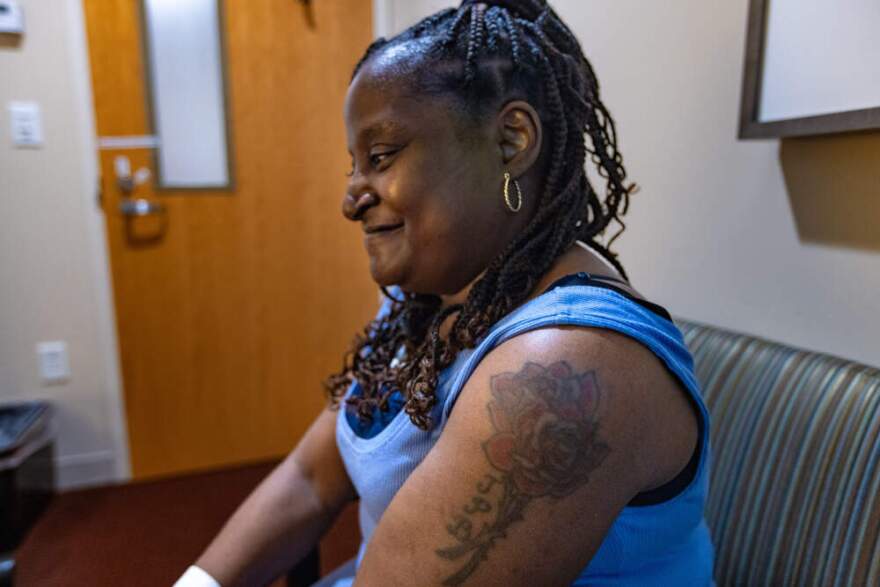It was about two years ago when Larisa Waya first met Charisse Pinkney lying in a hospital bed at the Dana-Farber Cancer Institute. Doctors and nurses had used their methods to treat her — pain meds, anti-nausea drugs and fluids pumping into her veins. But Waya, a chaplain who arrived to offer spiritual care, deployed a completely different set of tools: the butterflies, hearts, crosses and words inked on the woman’s skin.
Like many caregivers focused on the mind, heart or soul, chaplains recognize that some patients make their inner lives visible through their tattoos. By asking about them, exchanging tattoo stories or helping patients plan memorial ink, some chaplains find a way to understand patients on a deep level quickly, and create an opening with patients who would otherwise say “no thanks” to their services.
Pinkney has a blood disorder called sickle cell disease. Some of her red blood cells are shaped like little crescents instead of circles, and can get stuck in her organs, muscles and joints, causing excruciating pain.
“Basically my body attacks itself,” Pinkney said. “It can get pretty serious.”
Only the tattoos on Pinkney’s arms were visible above the sheet that morning as she struggled through the pain. Waya walked up to the bed, said hello and used the ink as a way to start a conversation.
Now, a couple of years later, the two women shared stories of their first meeting.
“I noticed there were beautiful, beautiful images on your arm,” Waya said, looking at Pinkney as she remembered the moment. “I made a compliment that this was really meaningful, what I saw.”

Meaningful, because Waya recognized the quote on Pinkney’s right forearm.
“Not all who wander are lost” was inspired by a poem from J.R.R. Tolkien’s “Lord of the Rings” trilogy. The books captivated Waya as a teenager growing up in Russia.
To Waya, it felt like the author was introducing the two women.
“The great writer and philosopher found you and sent a message,” Waya said to Pinkney. “It was amazing.”
On Pinkney’s arm, the words tether a heart to an airplane. The image illustrates why she loves to travel and explore new places, and explains her respect for people who choose less conventional lives.
In that first 15-minute conversation, the two women moved from discussing literature to social issues to Pinkney’s personal and family history.
“A whole world was brought into that visit,” Waya said, tracing a circle with her hands like the outline of a globe.

Waya visits Pinkney anytime she’s in the hospital now. She’s heard the stories behind almost all of Pinkney’s 30 tattoos: the memorial for her adored father, the butterflies that remind Pinkney that people or situations can change, and the words on the inside of each wrist that Pinkney looks at when she needs a boost. Fighter. Survivor.
“I feel like I’ve known her a lifetime,” Pinkney said. “She comes to see me and it just warms my heart because she cares about me.”
Waya is not an obvious tattoo evangelist. In Russia, she associated tattoos with criminals and prisons. Her faith, Orthodox Christianity, does not encourage tattoos. She doesn’t have any herself, mostly because she’s afraid of needles, but Waya is grateful to spot ink on a patient, especially when she’s called to a trauma or other emergency.
“There’s often not much time left for an encounter with the patient,” Waya said. “I’m a stranger, but within minutes they will give you their story.”
The connecting power of tattoos
In Chicago, Russ Goliger was called to one emergency after another during his first assignment as chaplain at Loyola University Medical Center in 2021. When he wasn’t responding to trauma calls, Goliger worked in the kidney and liver transplant unit where many of his patients had multiple tattoos.
Most of his patients were very sick, he said. Some had just learned there was no available organ for a transplant, which meant they could not expect to live much longer.
Goliger said the patients’ tattoos offered an opening to the life events, relationships and regrets these men and women wanted to process. These conversations helped them find some peace.
“It was transformative, for me, to be face to face with that,” he said.
Goliger had always been curious about tattoos, a curiosity fed while watching “Miami Ink,” one of the first reality TV shows about tattooing. In the hospital, it was a simple way to get to know his patients.
Simple perhaps, but not common. Kyle Christiansen with the Association of Professional Chaplains said he doesn’t know of any training programs that mention tattoos specifically, although they fit a chaplain’s mission.
“They are looking for all kinds of evidence or ideas that they can use to connect with the patient,” Christiansen said, “and that includes things like noticing tattoos.”
Christiansen said he has no idea how many chaplains get to know patients or clients via their tattoos, but most of the reports he hears are from chaplains in the armed services.
Some chaplains said their own tattoos have helped put patients at ease, because they subvert the expectation that a spiritual leader will be modest and conservative.
Heather Angell, a part-time hospital chaplain in Boston, has had to assure some patients she’s not there to convert them. She’s seen the expression change on patients’ faces when they spot ink on her forearms.
“When people see that, they think, ‘Oh, like this person is not exactly what I thought they were going to be, so maybe I can be a little open to them,’ ” Angell said.
Both of Angell’s tattoos are rooted in her Catholic faith: a ploughshare from the passage in Isaiah about beating swords into this farming tool, and the few loaves of bread and fishes that Jesus miraculously used to feed thousands. Angell said having any tattoos challenges patients’ expectations.
Tattoos and mourning
Angell has used hospice patients’ tattoos to guide them through distress. One man with cancer showed Angell a large, colorful tattoo he’d been proud of when his body was fit and muscular. But in his final months, when the man was very ill, the image seemed to shrink and look misshapen. It was a physical sign of his lost strength, mobility and independence.
“Even when someone knows they’re going to die from a terminal illness, there are all these small griefs to process, leading up to that,” Angell said.
Waya has also worked with patients nearing death, who see tattoos as a way to bridge the coming loss with family. A child might plan a memorial tattoo with a parent who’s dying. Or a mother might visit a tattoo artist one last time with her daughter, for matching tattoos.
“Wings of butterflies, for example,” said Waya, where the mom has one wing and her daughter the other. “It’s kind of sad. But it helps them to grieve.”
Lifting the taboo on tattoos
When Waya moved to the U.S., a chaplain mentor told her never to ask about a tattoo because it wasn’t appropriate to comment on a person’s body. But Waya has decided that if a tattoo is visible, it’s OK to offer a compliment or try an opening question like, “Does it have a special meaning?”
She joked that her Russian accent may also help her get away with some questions that could seem impertinent coming from another person.
Not all tattoos lead to deeper conversation. Waya recalled a man whose skin was covered with rifles, AK-47s and pistols “because he just liked guns.” Other chaplains said they don’t typically ask for the story behind a naked pin-up girl or a symbol they aren’t comfortable discussing.
Many tattoos have a complex history. Some have symbolic meanings familiar to anyone immersed in the culture and art of body ink. But Waya said very few of her patients turn down her request to learn about their tattoos.
“I wouldn’t even feel complete if I came here and went to the appointment without seeing her,” said Pearlie Rose Burke, another Dana-Farber patient of Waya’s who has sickle cell disease.
Burke’s father is a Pentecostal minister in Boston, and she attends his church. When Waya heard that, she assumed tattoos would not be part of their conversations.

Burke was praying in the hospital chapel one day when Waya spotted the large rose on Burke’s upper arm. Waya was so shocked, Burke didn’t reveal her second tattoo right away.
“I was like, I think that’s all she can handle, I’ll leave this one alone for a bit,” she said.
But when Burke told Waya the story behind each tattoo, explaining that they are connected to her three children, Waya understood.
“I always ask my patients, ‘What keeps you going, what motivates you?’ ” said Waya.
The answer was in the ink on Burke’s skin, in the tattoos she’d gotten to honor her children.
“Family is everything,” said Burke.
Martha Bebinger is working on a book about tattoo culture in the U.S. Reporting for this story was done in conjunction with that project.
This article was originally published on WBUR.org.
Copyright 2025 WBUR

